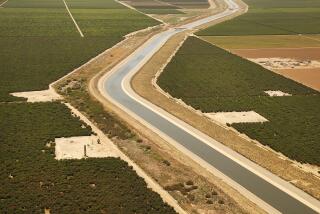$1 billion in California drought relief may just be the beginning
Gov. Jerry Brown and top lawmakers from both parties announced Thursday a $1-billion plan to deal with California’s persistent drought, describing the legislation as a mix of short-term relief and support for long-term water projects.
“This is a struggle,” Brown said at a Capitol news conference. “Something we’re going to have to live with. For how long, we’re not sure.”
Millions of dollars would be spent faster than previously scheduled to provide food assistance and emergency drinking water in hard-hit communities. Additional money would go to wildlife preservation.
The bulk of the legislation would fund infrastructure initiatives that might not be completed for years. The proposal includes $272.7 million from the $7.5-billion water bond approved by voters last year for projects such as water recycling and desalination.
An additional $660 million would go to flood-control projects, funded with a bond measure approved by voters a decade ago and scheduled to expire next year.
Asked how spending money on flood prevention would help the drought, the governor warned of “extreme weather events” caused by climate change.
“And with extreme weather events, you get drought. And then all of a sudden, when you’re all focused on drought, you can get massive storms that flood through these channels and overflow and cause havoc,” he said.
California is entering its fourth consecutive year of drought, and this latest proposal will mark the second consecutive year in which the Legislature has considered emergency drought relief.
In 2014, Brown signed a $687.4-million drought package, which offered aid to communities facing acute water shortages, and food and housing assistance to those harmed by the drought.
Brown was joined on Thursday by a bipartisan group of lawmakers -- Senate leader Kevin de Leon (D-Los Angeles), Assembly Speaker Toni Atkins (D-San Diego), Assembly Republican leader Kristin Olsen (R-Modesto) and Senate Republican leader Bob Huff (R-Diamond Bar).
De Leon said the new legislation would not be the last drought-relief proposal from the Capitol.
“This is just a down payment on our efforts to address the drought,” he said. “This is just the first round.”
The move comes amid growing concern about the state’s dry conditions. On Tuesday, the State Water Board tightened its watering restrictions, telling urban agencies to limit the number of days residents can water their yards.
The board that it will impose even tougher restrictions in coming months if local agencies don’t ramp up conservation efforts.
“We are not seeing the level of stepping up and ringing the alarm bells that the situation warrants,” said Felicia Marcus, chairwoman of the State Water Resources Control Board.
On Thursday, Brown said more restrictions could be on the way.
“Don’t have any doubts we’re going to increasingly control the use of water,” he said.
Huff echoed the need for Californians to use less water.
“Everyone in the state has to ask the question -- how can I conserve more water?” he said.
The state’s water situation is in some respects slightly better than it was a year ago. Precipitation in key watersheds in Northern California is 81% of normal for the date. Shasta Lake, California’s largest reservoir, is 58% full, compared with 45% a year ago. Lake Oroville is half full, compared with 45% at this time last year.
Customers of the State Water Project, which delivers supplies from Northern California to Southland cities, will get 20% of their contract requests, compared with only 5% in 2014.
But some smaller reservoirs in the southern Sierra Nevada have less in reserve than they did last spring. And most troubling to water managers is the statewide snowpack. At 12% of average, it has all but disappeared. At this time last year it was 28% of average.
The mountain snowpack acts as a natural reservoir that in a normal year can hold as much as a third of the state’s water supply, slowly releasing it throughout the spring as seasonal water demand rises. This year that release will be a trickle.
Times staff writer Bettina Boxall contributed to this report.
Follow @melmason for more on California government and politics.
More to Read
Start your day right
Sign up for Essential California for news, features and recommendations from the L.A. Times and beyond in your inbox six days a week.
You may occasionally receive promotional content from the Los Angeles Times.








